
Navarretia is a genus of about 30 species of flowering plants related to the phloxes and the gilias. This is one genus of plants, among others, which are sometimes called pincushionplants. The inflorescence which bears the flowers is surrounded by frilly green bracts bearing soft spines, giving it the appearance of a pincushion. Several species are members of the vernal pool ecosystem.

Calochortus weedii is a North American species of flowering plants in the lily family known by the common name Weed's mariposa lily.

Navarretia atractyloides is a species of flowering plant in the phlox family known by the common name hollyleaf pincushionplant.

Navarretia cotulifolia is a species of flowering plant in the phlox family known by the common name cotulaleaf pincushionplant, or cotula navarretia.

Navarretia divaricata is a species of flowering plant in the phlox family known by the common name mountain navarretia, or divaricate navarretia. It is native to western North America from British Columbia to Montana to California, where it grows in open habitat types.

Navarretia fossalis is a rare species of flowering plant in the phlox family known by the common name spreading navarretia.

Navarretia hamata is a species of flowering plant in the phlox family known by the common name hooked pincushionplant.

Navarretia heterandra is an uncommon species of flowering plant in the phlox family known by the common name Tehama pincushionplant, or Tehama navarretia.

Navarretia heterodoxa is a species of flowering plant in the phlox family known by the common name Calistoga pincushionplant. It is endemic to the San Francisco Bay Area in California, where it grows in the serpentine soils of the hills and mountains.

Navarretia leucocephala is a species of flowering plant in the phlox family known by the common name whitehead pincushionplant, or whitehead navarretia. It is native to North America, including much of the western United States and central Canada. It generally grows in wet or moist terrestrial habitat such as vernal pools.
Navarretia mellita is a species of flowering plant in the phlox family known by the common name honeyscented pincushionplant.
Navarretia prolifera is a species of flowering plant in the phlox family known by the common names bur pincushionplant and yellow bur navarretia. It is endemic to the Sierra Nevada foothills of California, where it grows near running water.
Navarretia prostrata is an uncommon species of flowering plant in the phlox family known by the common names prostrate pincushionplant and prostrate vernal pool navarretia. It is endemic to California.

Navarretia pubescens is a species of flowering plant in the phlox family known by the common name downy pincushionplant.
Navarretia setiloba is a rare species of flowering plant in the phlox family known by the common names Paiute Mountain pincushionplant and Piute Mountains navarretia.
Navarretia tagetina is a species of flowering plant in the phlox family known by the common names marigold pincushionplant and marigold navarretia. It is native to the western United States from Washington to central California, where it grows in wet grassland habitat such as vernal pools. It is a somewhat hairy annual herb growing up to about 30 centimeters tall. The leaves are deeply divided into many spreading needlelike lobes. The inflorescence is a cluster of many flowers surrounded by leaflike bracts. The flowers are pale blue and about a centimeter long.
Navarretia viscidula is a species of flowering plant in the phlox family known by the common name sticky pincushionplant.
Pectocarya peninsularis is a species of flowering plant in the borage family known by the common names Baja pectocarya and peninsular pectocarya. It is native to the Sonoran Desert of California and Baja California, where it grows in open desert habitat, including disturbed areas. This is an annual herb producing a slender, rough-haired stem, decumbent or upright form to a maximum length of about 24 centimeters. The small, pointed linear leaves are alternately arranged, widely spaced along the stem. The inflorescence is a series of flowers, each on a curved pedicel. The flower has small green sepals and tiny white petals. The fruit is an array of four nutlets each lined with comblike prickles, those higher on the plant arranged in pairs and the lower ones unpaired.
Navarretia ojaiensis is a rare species of flowering plant in the phlox family known by the common name Ojai navarretia.
Argyrochosma peninsularis is a fern endemic to Baja California Sur. It grows in dry, rocky places. First described as a species in 1939, it was transferred to the new genus Argyrochosma in 1987, recognizing their distinctness from the "cloak ferns". A dusting of powdery material and the presence of occasional scales on the central axis of its leaves help distinguish it from related species.
This page is based on this
Wikipedia article Text is available under the
CC BY-SA 4.0 license; additional terms may apply.
Images, videos and audio are available under their respective licenses.










